| The Queen's Hall Darlaston's first cinema was the Queen's
Hall in Willenhall Street, known locally as the
“Blood Tub”. The hall had previously been used
as a Sunday school by the Bell Street Primitive
Methodist Chapel, which closed in 1908. The
chapel had been badly damaged by a subterranean
coal fire, and so in 1910 the congregation moved
to the new chapel in Slater Street. After
closure, the old chapel and Queen’s Hall were
sold. |
|
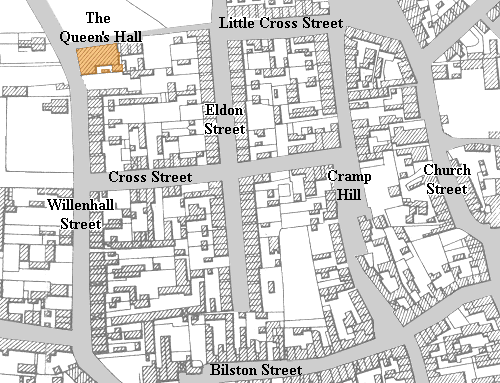
The location of the Queen's
Hall. |
The Hall then became Darlaston’s only
theatre, and its first cinema. Plays were
organised by Gus Levaine who ran the Darlaston
theatre company and another in Cradley Heath.
The members were Marie Aston, Dot Claire,
Vera Cook, Bert Evans, Gus Granville, Billy
Glen, Jack Igo, Cyril Lane, Denise May, Linda
May, Ruby Mildred, and Billy Russell. They
performed a different show every week including
dramas, farces, variety, and pantomimes, and
made all of the costumes, scenery, and props. |
|
Billy Russell,
who later made a name for himself as a comedian,
was only about seventeen years old when he began
working for Gus Levaine. Whilst working at the
Queen’s Hall he stayed with his Aunt May who
lived in a bungalow opposite the hall. He was
paid twelve shillings and sixpence a week, out
of which eight shillings went to his aunt for
board and lodgings, and for washing his clothes.
His duties included scene painting, making
props, doing odd jobs, and small acting roles in
each production.
It was known
locally as the "Blood Tub" because most of the
plays included at least one murder. There were
plays such as "Sweeny Todd", and "Maria Martin
and the murder in the Red Barn".
Films were
initially shown during the break in the middle
of each production, well before 1910 when the
Cinematograph Act of 1909 was implemented. After
the passing of the Act, the hall obtained a
licence to show films. It was over a year later
that the Picturedrome, and the Olympia opened
their doors for the first time.
The cinema was
a make-shift affair. The projector stood on a
small platform above the pay box at the rear of
the hall. In 1916 the hall lost its cinema
licence, possibly because it did not comply with
the strict building code, and fire regulations
that had been implemented. The plays and variety
shows ceased around the end of the First World
War, and the hall closed. After a short life as
a warehouse, the hall was demolished to make way
for the houses that are still there today. In the 1914 - 1918 world war many people joined the
local regiments and went to fight in France. Local
factories also played their part by producing munitions
for the war effort. Two hundred and sixty eight
Darlaston people were killed in the war. The war
memorial in Victoria Road, built as a tribute to
them, was completed in the mid 1920s. |
| The Picturedrome Darlaston opened its first purpose-built cinema, the Picturedrome,
at Crescent Road in 1911.
The first owner is believed to
have been George Williams.
In 1922 he sold it to Mr. Brettell of the Hockley Picture House Company.
It
later became part of Colmore Entertainments Ltd. It was
equipped to show cinemascope in 1956. The manager in
1956 was Mr. A. Webb, the licensee being Mr. V. I. Olliver.
The cinema closed on 2nd February, 1959. The last
films were "Escort West" and "Guns, Girls and
Gangsters". It was demolished in the summer of 1963. |
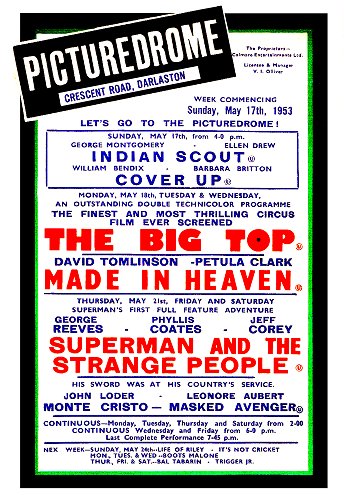 |
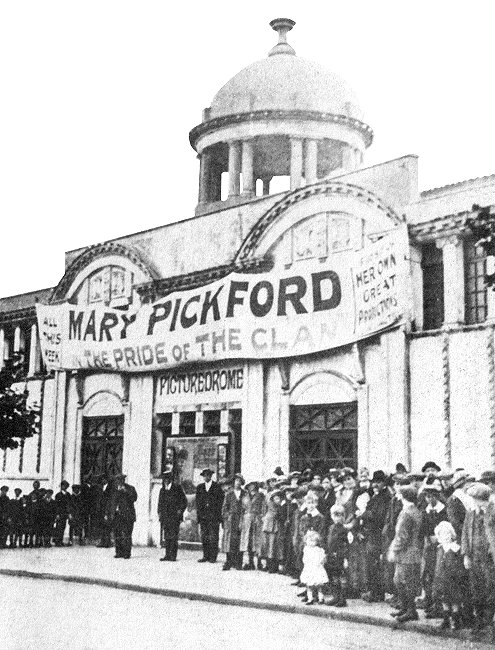 |
The Picturedrome in 1917,
when it was an extremely popular venue. |
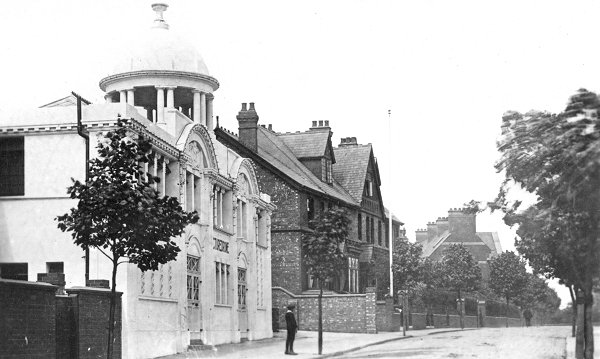
The Picturedrome. From an old
postcard.
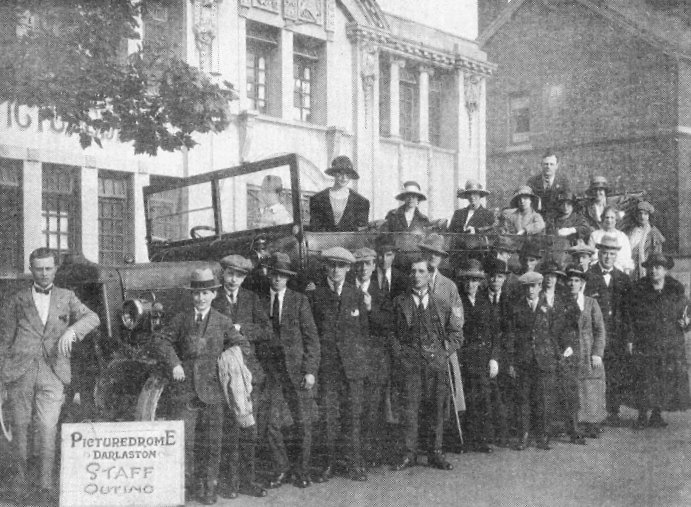
A staff outing from the 1920s.
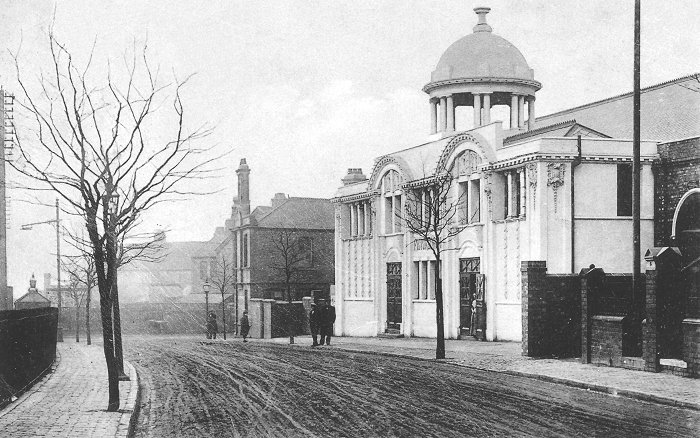
Another view of the Picturedrome, also
from an old postcard.
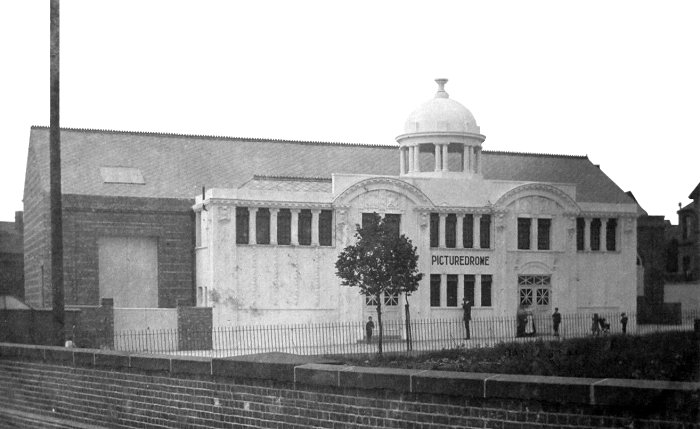
The Picturedrome, as seen from Walsall
Road railway bridge. From an old postcard.
| A
cinema not to be forgotten is the
infamous Olympia, locally known as "The Limp" which
opened on 15th November, 1911 with the film "Death
Before Disaster".
It was originally built as a skating
rink by Mr. Laycock and converted into a cinema by local
builder William Taylor Lees. Its situation in Blockall,
above the South Staffordshire coalfield led to a
chequered career.
|
|
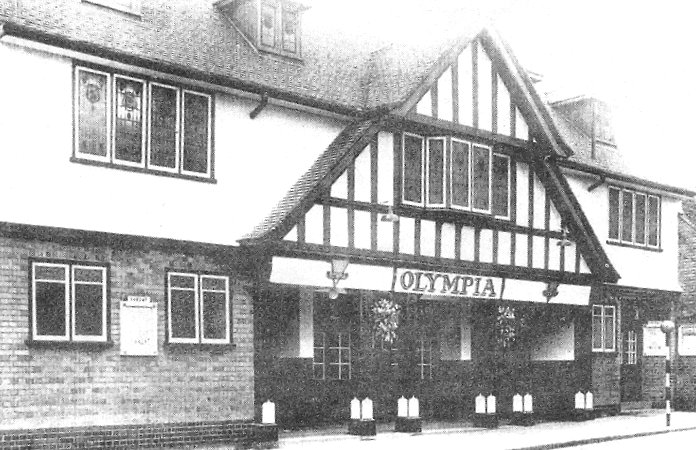
The Olympia cinema. |
|
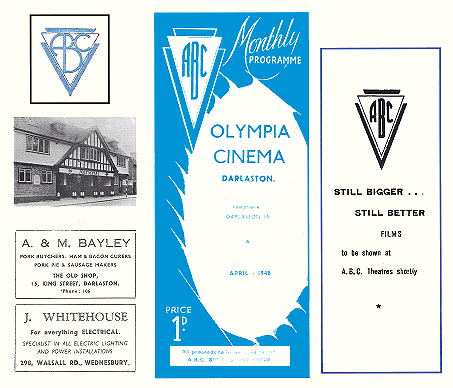
Courtesy of Tony Highfield. |
Underground fires were not uncommon in
the area due to the thick seams of coal.
Once started,
such a fire could burn for many years. Unfortunately
the Olympia stood in an area that was prone to such
fires and suffered accordingly.
In 1913 the wooden floor
was replaced with concrete because of the fires.
Older people have recalled visits to the cinema
during the fires. Watching a film could be an
uncomfortable experience due to the heat, especially
in the summer months. |
|
Around 1913 the cinema was
acquired by Pat Collins who sold it to C.D. Cinemas in
1926, and they in turn sold it to A.B.C. The last film,
shown on 10th December, 1955 was "Thousands
Cheer" starring Gene Kelly.
After being used as
a car showroom
for several years, the building was demolished in the
mid 1960s. |
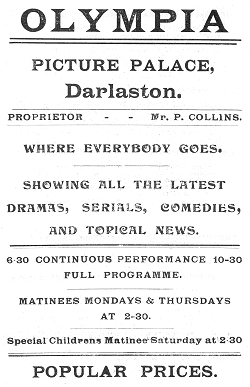
An advert from 1921. |

A final view of the
Olympia and the Dog and Pheasant pub, known as
'The Wrexham'. From the collection of the late
Howard Madeley. |
| The Regal The last cinema in Darlaston; the Regal in Pinfold
Street opened on the 19th of September, 1938. The first
film was "Make a Wish" starring Bobby Breen, and a
Mickey Mouse cartoon called "The Boat Builders". The
entertainment also included a singer on the stage, and
Leslie Taff played the organ. The admission for the
evening was just 6d, 9d, 1 shilling, or 1 shilling and
6d. |
|
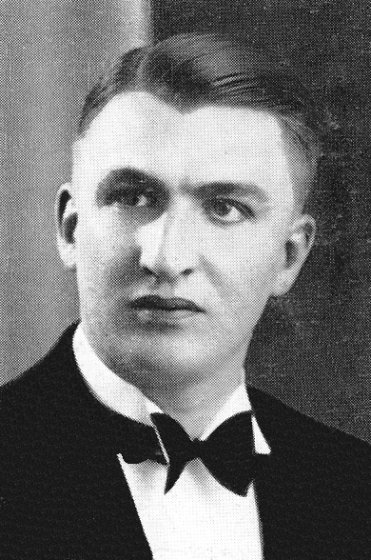
Leslie Taff. |
Leslie Taff was born in Tipton and started playing
the piano for silent films at the age of 11 at the
Victoria Palace in Railway Street, Horseley Heath. He
played in cinemas at Swindon, Clapham, Kilburn, and
Shepherds Bush, before working in the Midlands at
cinemas in Wolverhampton, Coventry, and Birmingham.
Before coming to the Regal he played at the Tower
Cinema, West Bromwich, and the Gaumont Palace in
Birmingham.
He also became a
frequent performer of cinema organ music on the BBC Home
and Overseas Services, often broadcasting from the Regal
itself on the Compton organ. Leslie was at the Regal for
many years and became a familiar figure in the town.
The building, built by J & F Wootton Limited, and
designed by Ernest Roberts, seated 1,043 people
downstairs and 372 on the balcony. It was run by Colmore
Entertainments. The Regal had a large stage that was
used for Sunday evening concerts during World War 2
featuring famous midland entertainers of the day. |
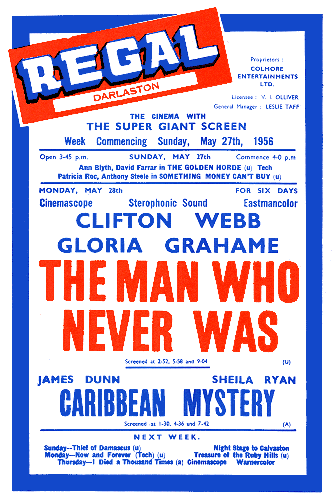 |
|
 |
|
Courtesy of Tony Highfield. |
|
The
Regal on a wet night. Photographed by the
late W. J. Ashmore on 27th December, 1938. Courtesy of John & Christine Ashmore. |
|
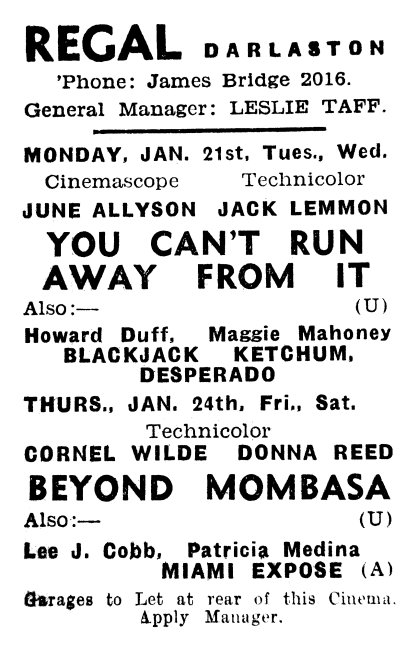 |
From the Tipton Herald
newspaper.
January 1957. |
| From the Tipton Herald
newspaper. January 1957. |
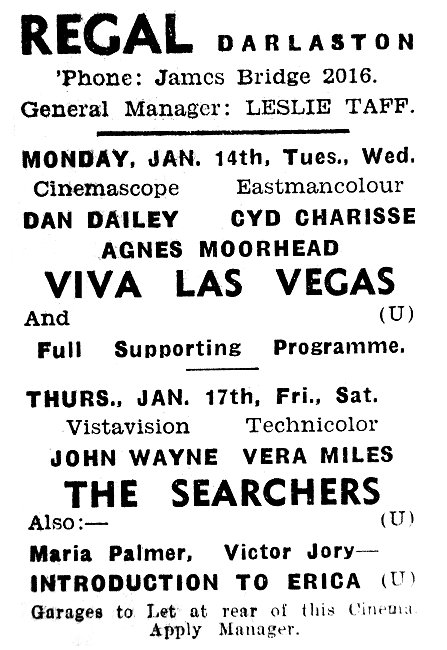 |
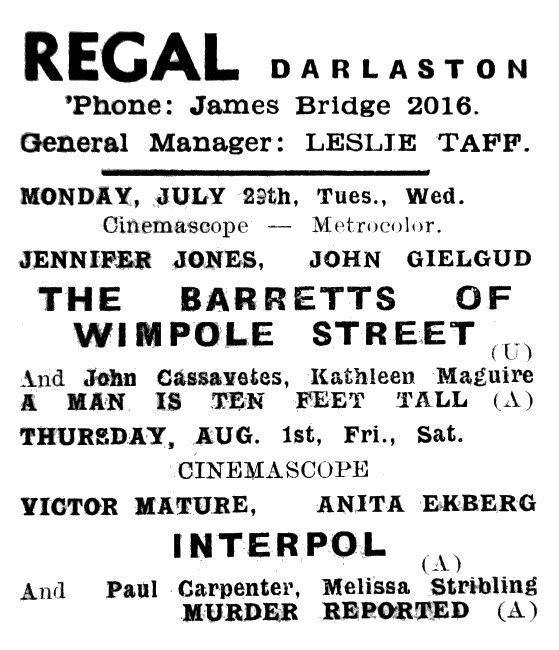 |
From the Tipton Herald
newspaper. July 1957. |
From the Tipton Herald
newspaper.
September 1957. |
 |
|

The Regal in the late 1930s.
|
The last film, "Duel of the Titans" starring
Steve Reeves was shown on 1st February, 1964.The next day the Regal started a new
life as a Bingo club. This was very successful and
included a restaurant, but in the 1990s attendance's
began to fall, and it finally closed in 1994.
In mid
1995 the building was broken into and suffered an arson
attack which resulted in severe internal damage to the
structure. Demolition followed a couple of months later. |
| The Regal's Compton Organ.
From an old programme. |
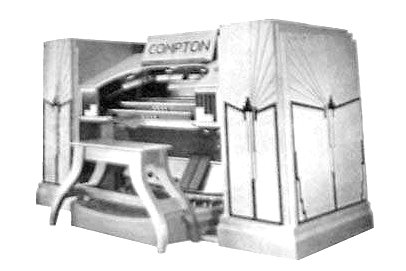 |
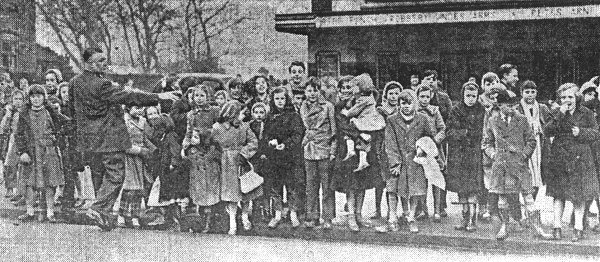
Leslie Taff escorts a
group of young film fans across Pinfold Street
as they leave the Regal, some time in 1958. From
an unknown newspaper. Courtesy of
|
| A group of youngsters
outside the side entrance of the Regal in 1958.
From an unknown newspaper.
Courtesy of
|
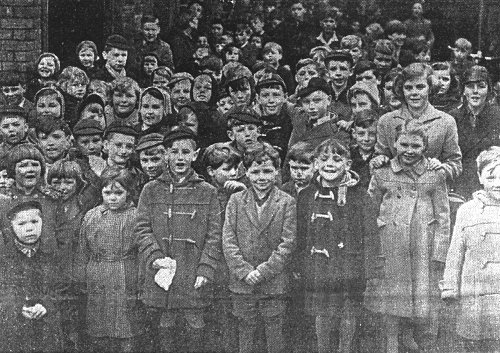 |
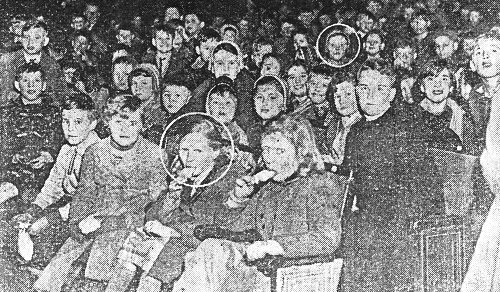 |
A young appreciative
audience in the Regal in 1958.
From an unknown newspaper.
Courtesy of
|
 |
 |
 |
Return to Into
the 20th Century |
Return to
Contents |
Proceed to The
Inter-War Years |
|